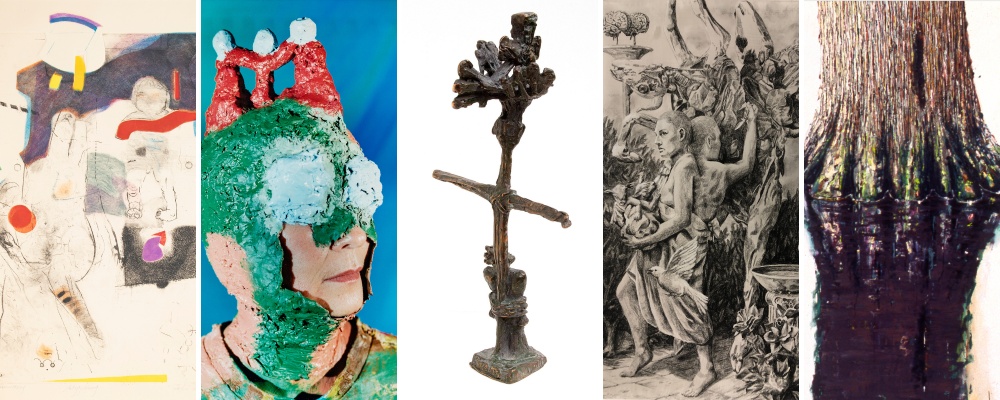Blog
Contemporary Interpretations of Ancient Stories
January 02, 2023

Images (left to right): Punishment of Prometheus (detail), Takeshi Takahara, etching, 1973. 1998.253.1; Ode to Hephaestus (detail), Patrick Millard, carbon pigment photographic print, 2005. 2021.80.47; Ulysses and Siren (detail), Dmitry Kaminker, cast bronze. 2004.0390.1; Europa and the Bull (detail), Gavin Weir, ink, charcoal and conte pencil on paper, 2019. 2019.29.1; Narcisse #2 (detail), Vera Klement, oil on canvas, 1999. 2021.29.3.
Greek mythology can be found in nearly every form of popular culture. Myths have been re-told and adapted into everything from novels, poetry, movies, TV shows and video games. These stories, often taking visual forms, have been preserved and transformed by artists throughout time.
While there is no one unified written source of Greek mythology, sources like Homer’s Iliad and Ovid’s Metamorphoses provide rich stories of humanity, from the creation of the first woman to the downfall of Troy. The stories resonate across time, representing aspects of the human condition that are as relevant now as when the Greeks first imagined them.
Artists have captured these stories since the ancient Greek sculptors carved marble representations of gods and goddesses. This tradition has been continued by modern and contemporary artists. From Caravaggio and Michelangelo to Picasso and Damien Hirst, many artists have addressed and reinterpreted mythologies in their works. The GVSU Art Collection has a number of artists engaging elements of ancient narratives in their work, from works on paper and traditional sculptures to large scale paintings and photography.
Takeshi Takahara:
In his etching, “Punishment of Prometheus,” artist Takeshi
Takahara tells the tale of a Titan god of fire, a known trickster. The
Greek poet Hesiod told a story of Prometheus tricking Zeus into
accepting a pile of bones and fat as sacrifice instead of a hidden
stash of meat. Out of rage, Zeus stole fire from mortals, which later
was stolen back and returned by Prometheus. As a larger punishment,
Zeus created Prometheus’ future wife, Pandora, the first mortal woman
in Greek mythology, and would later release the ills of humanity into
the world.
To learn more about Takahara’s work in the GVSU Art Collection visit: https://artgallery.gvsu.edu/Detail/entities/540
Vera Klement:
In her painting, “Narcisse #2,” Vera Klement focuses on the lower
trunk of a tree, seemingly floating against a stark white
background. Rooted in its reflection the tree that confronts us
references Narcissus, the Greek mythological story of a hunter known
for his beauty who fell in love with his own reflection in a pool of water.
To learn more about Klement's work in the GVSU Art Collection visit:https://artgallery.gvsu.edu/Detail/entities/3621
Patrick Millard:
For Patrick Millard’s photographic series, “Ode to Hephaestus,”
he created masks for his models to wear, representing the appearance
we put on for others, hiding the true core of our personalities. In
Greek mythology, Hephaestus, the son of Hera, was born with features
the gods and goddesses could not appreciate, so Hera cast her son out
of Mount Olympus. Hephaestus fell for a night and a day until he
landed on the island of Lemnos. It was here that the Sinitians, a
barbarian people, discovered the god and worshiped him. Later seeing
his true worth, Hephaestus was brought back to Olympus and became a
master craftsman and blacksmith for the gods.
To learn more about Millard's work in the GVSU Art Collection visit:https://artgallery.gvsu.edu/Detail/entities/2537
Dmitry Kaminker:
Odysseus, later called Ulysses in Roman mythology, was the king
of Ithaca and fought against the Trojans in the Trojan War. Odysseus
is also the hero of the Homer’s epic poem, The Odyssey, the
story of his ten year journey to return to his home after the war. On
his journey he and his crew meet a number of characters trying to slow
down his progress including sirens, lotus-eaters and a cyclops.
To learn more about Kaminker's work in the GVSU Art Collection visit: https://artgallery.gvsu.edu/Detail/entities/613
Gavin Weir:
In the story of Europa and the bull, Zeus, enamored with Europa’s
beauty, decides to seduce her. He transforms himself into a white bull
and hid himself within Europa’s family’s herd. Europa sees the bull,
gets on his back, and Zeus runs with her to the sea, swimming to the
island of Crete where he reveals his true identity. Europa becomes the
first queen of Crete. In his rendition, artist Gavin Weir gives all
the characters two heads, suggesting dual personalities of the
characters, one that has good intentions to gain knowledge and sustain
the natural world, and another that is self-serving and manipulative.
To learn more about Weir’s work in the GVSU Art Collection visit: https://artgallery.gvsu.edu/Detail/entities/4894
